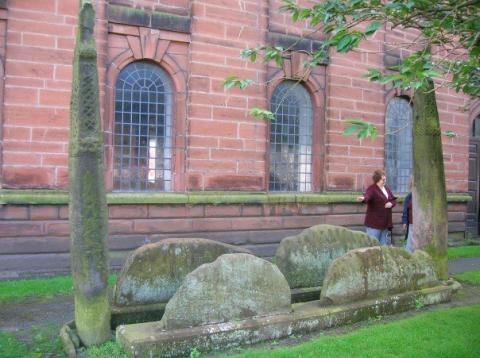Giant's Grave, Penrith

By Penrith Parish Church, Cumbria, are some large, 'hog-back' stones. They’re called the Giants’ Graves and are said to mark the resting place Owen or Ewan Caesarius, elected King of Cumberland in AD 920, who died in 975. He was said to be a huge man, which may not have been too hard considering the generally poor and sparse diet of Northern Europeans and their consequential stunted growth. Whether or not he was physically impressive, his kingship and martial prowess doubtless made him a feared ruler. To have reigned so long in that dark, violent time suggests his grip on power was firm. For this reason, they offered him an impressive grave, one that would keep future generations wondering. Similarly, I’ve been to the Mausoleo del Che Guevara, the huge tomb of the fallen Cuban revolutionary in Santa Clara. The man’s power, achievements and influence, rather than his physical stature, warranted so grand a memorial. Perhaps Owen meant as much to the Cumbrians as Che to the Cubans. Big man, big tomb.
The north-western hogback stone displays a weathered carving of a serpent and a human figure engaged in combat. Some interpret this as the Lord Jesus, whose death and resurrection dealt a lethal blow to Eden’s serpent. I’ve been to two places purporting to be Christ’s tomb. One is covered in a spawling, medieval cathedral, the other surrounded by a pleasant garden cloaked with diesel fumes from the neighbouring Jerusalem bus station. Whichever location was Christ’s actual burial, you’ll find there no body. The greatest Man who ever lived, far worthier and more potent than a Cumbrian king or Cuban revoluationary, dwells in no sepulchre, for death itself He conquered:
He seeing this before spake of the resurrection of Christ, that his soul was not left in hell, neither his flesh did see corruption. Acts 2:31
- Log in to post comments


 Sunday Worship 10.45am & 6.00pm
Sunday Worship 10.45am & 6.00pm